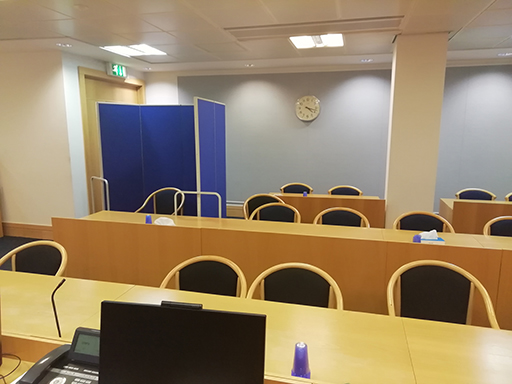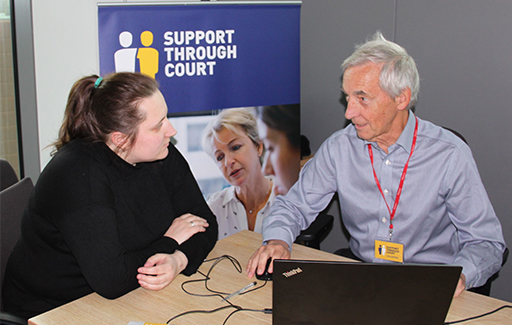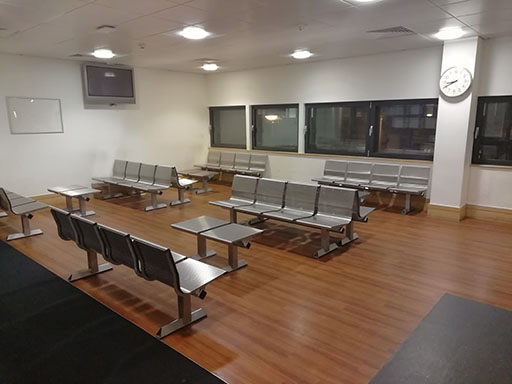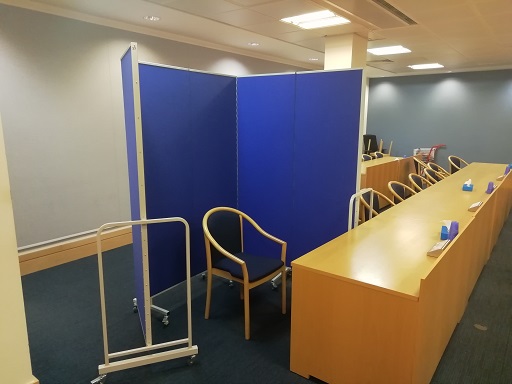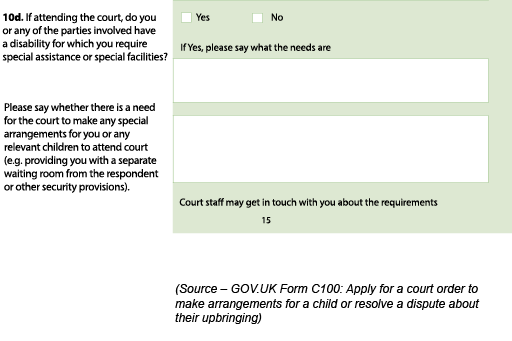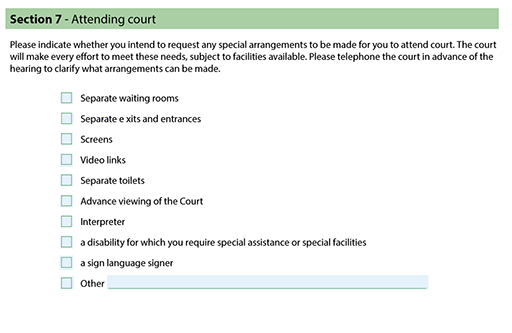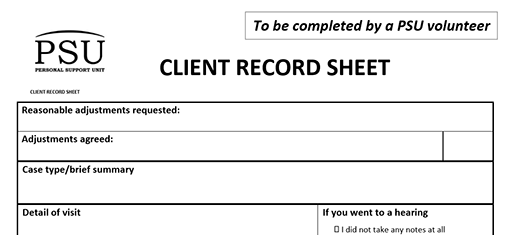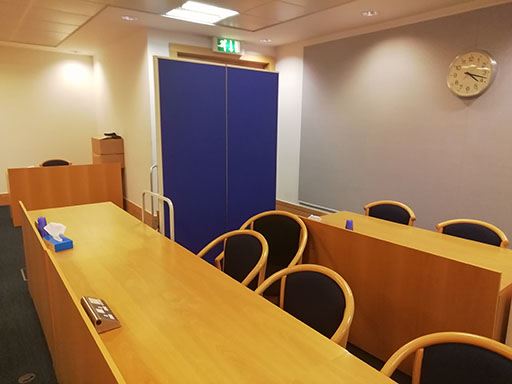Use 'Print preview' to check the number of pages and printer settings.
Print functionality varies between browsers.
Printable page generated Monday, 24 November 2025, 4:37 AM
Special measures
4.1 Introduction
Digital badge and Statement of Participation

This suite of training modules has been produced by Support Through Court and the Open Justice Centre (Open University Law School). It contains a series of modules to support volunteers in their work with members of the public who are involved in court proceedings.
These next seven shorter training modules contain practical advice and assistance on various aspects of client support. These include working with clients involved with special measures, Cafcass, improving your client interview skills, writing court statements, signposting to other organisations, and working with vulnerable clients.
There is an exclusive digital badge awarded for studying these shorter training modules. To gain this digital badge you need to complete all seven modules and pass the Modules 4–9 knowledge assessment.
Welcome to this training module on Special Measures. Special measures are arrangements the court makes to help vulnerable people take part in court proceedings. In your volunteering you may come across situations where clients require special measures to be put in place to assist them when attending court.
Special measures are designed to help vulnerable people in court. Used correctly, they can mitigate some of the anxiety a client may face and allow the client to participate more fully in proceedings or give evidence at a hearing. This training module will assist you in feeling more confident in situations where clients need special measures to take part in court proceedings.
Learning outcomes
This module will explain what special measures are available, when and how to apply for them and who to contact if they are not put in place for your client on the day of the hearing.
In this module you will learn about:
- What are special measures?
- Who can apply for them?
- Special Measures and domestic abuse.
- How do clients apply for special measures?
- What if special measures are not put in place on the day of the court hearing?
- How to support clients where the other party has requested special measures.
This module is one of a number of training modules to help Support Through Court volunteers when supporting clients. The modules all use the same case study to explore the different aspects of supporting clients effectively. We will be referring to this case study as we work though this module, so it may be helpful to remind yourself of the facts now. You may want to open this case study in a separate window (use Ctrl + click on the link) so you can refer back to it when needed. Find out more about the fictitious Johnson/ Smith family and their situation.
During the module you may come across terminology which is unfamiliar to you. Some words are hyperlinked to the Glossary, so by hovering over the word you will be able to see its definition.
The module will consider issues around domestic abuse, as these are some of the cases where special measures may be required. Statistics around domestic abuse show that women are more likely to be victims of abuse than men. For this reason, during the module we will be using ‘she’ to denote a female victim of domestic abuse and ‘he’ to denote the male perpetrator, as this is the scenario you are most likely to come across in your volunteering.
However domestic abuse can involve men as victims and women as perpetrators, as well as abuse within same sex relationships. Support Through Court supports all clients regardless of their circumstances and so you may come across different forms of domestic abuse relationships in your volunteering. This training will assist you to support clients whatever their gender or sexual orientation and regardless if they are alleged to have abused or are making allegations.
Please note
This module deals with some sensitive issues including descriptions of domestic abuse. These training modules are not compulsory, but they are recommended. If you do not feel comfortable to start the module, or if you are affected by the material, or feel you are unable to undergo the training, then Support Through Court can help you. Please speak to your Service Manager when you are next in the office.
If you need immediate support over the phone you can call:
National Domestic Violence Helpline – 0808 200 247
Finally this module deals with some sensitive issues including domestic abuse. If you are affected by the material, Support Through Court can provide support for you. To access this support please speak to your Service Manager.
Give your opinion
How would you rate your understanding of special measures right now, before you start this module? Submit your opinion.
4.2 What are special measures?
Special measures are adaptations, concessions or arrangements made by the family court to assist a vulnerable person to participate in proceedings or to give evidence at a hearing.
Activity 1
Can you think of any cases where your client has been vulnerable or frightened?
What, if anything, did the court do to assist the client to take part in the hearing?
Comment
You may have already been involved in cases which involved special measures, or you may not yet come across this as a volunteer. Understanding why special measures are put in place, when they can be used and what arrangements can be made will help you support clients better to participate in their court proceedings. We will go on to look at the wide range of special measures which can be put into place in the next section.
4.3 What special measures can be put into place?
The courts have set out the different types of special measures which can be made in the Family Proceedings Rules (FPR) and Practice
Activity 2
Here are some of the measures the court can put in place. Click on each picture below to read a little more about it.
Find out more
If you want to find out more about the types of special measures that can be made, you can read the rules governing the use and application of special measures. You do not have to do this. If you are interested, you will find them in the
4.4 Who do special measures apply to?
The court rules say that special measures are for “vulnerable people”.
Activity 3
What characteristics or situations would make someone vulnerable? You may want to think about the situations you have dealt with in your volunteering.
Comment
The court rules say that when considering whether someone is vulnerable, the court will consider a number of things. These include:
- the impact of any actual or perceived intimidation towards the person concerned
- whether the person has a mental or physical disability or is undergoing medical treatment
- any concerns about abuse
- whether the court hearing is contentious
- the person’s age, maturity and understanding
- the person’s social and cultural background and ethnicity
- the person’s domestic circumstances and religious beliefs
- the questions the person will be answering in court
- any other relevant characteristic.
The court will also consider what measures could be put in place to assist the person and the cost of those measures.
As you can see, the court doesn’t just look at the characteristics of the party (such as a disability or health issue, age, social or cultural background) but also the circumstances. For example, special measures can be appropriate where there has been any intimidation or abuse and where the matter is contentious.
Crucially, when deciding whether special measures are appropriate the court will consider whether any of these characteristics or circumstances means the person will be less able to participate in the court proceedings or hearing. They will therefore look at whether the person will have difficulties in understanding the court proceedings and the client’s role, putting their views to the court, instructing legal representatives (if they have them) or attending a court hearing without “significant distress”.
Activity 4
Were there any of these characteristics or circumstances which surprised you, and if so why?
Comment
Your response will be affected by your previous volunteering experiences and the extent to which you have supported clients who are vulnerable. You may have already been aware of the wide range of circumstances where special measures could apply, or this might be new information for you.
Can you recall any cases you have been involved with where special measures could have been considered, but were not? If so, can you identify a reason why special measures were not considered? Are there any things you would do differently in the future in your volunteering as a result of knowing this information?
Thinking about these questions will help you in your support of clients going forward.
Activity 5
You will find below a list of possible vulnerabilities. Use the highlighter pen to choose which special measure may be most appropriate in these circumstances.
How to use the highlighter
Each coloured highlighter has a description detailing its function. Click on the colour you want to use and then drag your cursor over the text you want to highlight. The return arrow icon erases the single last highlighting you did. If you want to clear all of your highlighting use the Reset button. When you have completed all of your highlighting click on the Save button. To check your answers click on Reveal answer.
Green – to prevent a party or witness from seeing another party or witness.
Blue – to provide for a party or witness to be questioned in court with the assistance of an
Red – to give evidence by live link.
Purple – to provide for a party or witness to use a device to help them communicate.
4.5 Special measures and domestic abuse
Special measures often need to be considered in cases involving domestic abuse. You read in the last section that concerns about abuse, intimidation and whether a matter is contentious are all relevant when considering whether special measures are appropriate.
Activity 6
What types of behaviour amount to abuse which the court can take into account when considering whether special measures are appropriate?
Comment
The court will consider a range of different types of abuse including domestic abuse, sexual, physical or emotional abuse, forced marriage, “honour based violence”, female genital mutilation and human trafficking. They will also consider any abuse or discrimination due to race, culture, gender or sexual orientation.
Did you know?
The most common
If you are interested in finding out more, please look at Support Through Court’s first training module on domestic abuse called Introducing Domestic Abuse.
Activity 7
In our case study, Jazmin has been in a relationship with Steve where there has been a history of domestic abuse. She was controlled by her partner to the extent that it affected her mental health. Eventually, she was able to escape the relationship and she moved into emergency accommodation with her two children. If you need a reminder you can read about the family again.
A support worker at the refuge helped Jazmin to get some free legal advice. The solicitor has advised Jazmin to obtain a Child Arrangements Order. Jazmin approaches you in the Support Through Court office for help.
From your experience as a volunteer, what are clients most afraid of in coming to court in these circumstances?
Comment
You may have thought of a number of considerations. It may be that they are most afraid of losing their children. A common concern is that people are afraid of seeing their abuser in court or bumping into them at the waiting areas.
Did you know?
As part of the special measures which can be made, many courts have separate waiting areas away from the public waiting area where individuals can wait for their court hearing without fear of meeting the other party.
Jazmin describes her experiences whilst living with Steve as follows:
“At first Steve and I got on really well. He was always very generous and complimentary. After I became pregnant, his behaviour towards me changed. He started to get really jealous of me and my friends. He would behave badly if they came around and eventually they stopped coming over. I was so tired looking after our baby and making sure Steve got what he wanted that I didn’t have time to myself anymore.
Steve started taking the child benefit money and spending it on drink. He would give me what he called ‘housekeeping’, so I could buy food and clothes for our daughter. He would not give me any money for Jaden, my son from a previous relationship. Some days I didn’t have enough money to buy food for myself so I went hungry. He was always checking up on me and he would get really angry when I didn’t do what he wanted. I tried to leave a couple of times but he would always talk me into coming back. He said he loved me and begged me to stay.
One day, I was late back from a doctor’s appointment. He went mad at me, saying I was having an affair. He smashed the place up and punched me in the face. I was holding our daughter at the time and Jaden was in the house, hiding in his bedroom. A neighbour called the police and they came and took him away. I was scared that when he got home he would do something worse, so whilst he was out of the house I managed to get away and get a room in a women’s refuge.
I have heard that he is trying to find where I am staying and wants to take the children from me. I am really scared.”
Activity 8
Which of these experiences would be evidence of concerns about abuse or intimidation, which might allow Jazmin to make an application for special measures?
Comment
The clearest evidence would be that Steve had assaulted Jazmin. However, not all domestic abuse involves violence. Evidence of Steve’s controlling behaviour could also be used to support an application for special measures. You can learn more about coercion and control in the first training module on domestic abuse called Introducing Domestic Abuse.
Activity 9
As a volunteer you need to consider which special measures might help Jazmin to attend court without significant distress and put her views to the court.
Look at the following images of special measures. Click on the image that you think may be most appropriate in Jazmin's situation.
There is one correct answer.
Answer
The special measure image below may be the most appropriate in this situation:
The image depicts measures to prevent a party or witness from seeing another party or witness.
The other options in the images were:
Intermediary – Jazmin is able to communicate well and understand what is being said in court. So, this measure would not be appropriate for her.
Aids to communication – Jazmin is able to speak for herself and when she talks people can hear her and vice versa. So, this measure would not be appropriate for her.
Video link – whilst giving evidence by live link would certainly make Jazmin feel more comfortable and reduce her anxiety, Judges will tend to prefer to speak to a party in person. Special measures must be proportionate to the level of need and, therefore a video link would probably be seen as disproportionate. Especially if it was felt that other, less obtrusive measures could achieve the same result.
Separate waiting area – this would be useful for Jazmin as she may be intimidated by Steve in the waiting area. However, if she then has to face Steve in court this might prevent her from participating fully due to the anxiety caused by seeing Steve in the court room.
Anything else – a Judge can order any adjustment they see fit if it will assist the parties to be able to partake more fully in the proceedings. Jazmin’s needs can be accommodated through the use of other measures listed in this activity
4.6 How are special measures applied for?
Some special measures require the approval of the court. It is important to apply in the correct way, with sufficient notice. Remember not all courts have all special measures available.
Did you know?
If the special measures are not available in the courtroom at the court where the case is heard, the judge can order the case to be heard in a different courtroom or even a different court building where the special measures are available.
Your local court should have a form which will alert the court to the request for special measures. Each court has their own system for requesting special measures. There should be forms in the Support Through Court office.
Form C100: Section 10
If the client is applying for a child arrangement order, they will apply on
a.
The time of the court hearing.
b.
Why the party would benefit from assistance.
c.
The colour of the screen required in court.
d.
The requested gender of the Judge.
e.
The special measure that is required.
f.
Why the measure would improve the person’s ability to give evidence or participate.
The correct answers are b, e and f.
Answer
The following information should be included in a special measures request:
Why the party would benefit from assistance.
What special measure is required.
Why the measure would improve the person’s ability to give evidence or participate.
Feedback
It is important to clearly explain what is required, why the party needs it and how it will benefit them to give evidence.
Activity 10
You are assisting Jazmin to apply for special measures for the
Comment
You may have included the following.
A separate entrance, secure waiting room and screens are required as the applicant has experienced violence and control from the respondent. She is afraid of going into the court building and accidently meeting him. The measure will allow the applicant to attend court and give evidence without intimidation in the court.
Jazmin will also need to fill in form C1A, which must be completed whenever there are allegations of harm and domestic abuse. In Section 7 requests for special measures can be made.
4.7 What if special measures are not put in place on the day of the court hearing?
Although you may have assisted the client to apply for special measures and these could have been granted by the court, you may come across situations where the arrangements have not been made on the day of the hearing.
Clients will usually know if they have requested special measures. It is good practice to record a request on the Client permission and consent form so that other volunteers who may be supporting the client are aware.
Prevention is better than cure, so volunteers should encourage the client to check with the court the day before the hearing that they have received the request and are actioning it (it is not for the volunteer to check in advance).
When assisting the client to ‘book in’ with the usher, volunteers should support the client to check with the usher that measures are in place.
Sometimes, a vulnerable client has not been to Support Through Court previously and arrives on the day of the hearing feeling frightened, but unaware that special measures might be available. In this case, support the client to ask the usher to ask the judge if it is possible to request the measure, but be aware that the request may be refused.
Activity 11
In our example, Jazmin applied for special measures. It is now the day of the first hearing and you are supporting Jazmin at the FHDRA. She is anxious that screens are in place for the hearing. The usher is unaware of the application for screens and none have been organised.
What could you do to support Jazmin?
Comment
In the event that the measures are not in place, you can assist the client to establish the reason why. It may be that the judge has not authorised the measure, in which case, there is little you can do to change that decision.
You can try and mitigate any issues, for example by ensuring the client is kept away from the other party. You could also organise with the usher to stagger the timing of the parties entering and leaving the court room and seating themselves between the parties.
If there has been an error or omission on the part of the court or client, then you should work with the client and the court staff to organise the special measures.
Did you know?
Did you know? It is important that the volunteer makes the Service Manager aware of any situation where special measures have not been put in place, so that issues are fed back to HMCTS through the appropriate channel.
4.8 What if you are supporting a client where the other party has requested special measures?
Support Through Court assists all people attending court and so you may be asked to support a client where the other party has requested special measures.
Activity 12
Give your opinion
How would you rate your understanding of Special Measures after completing this module? Submit your opinion.
4.9 Your volunteering and special measures
This module has explained what special measures are available, when and how to apply for them and who to contact if they aren’t put in place for your client on the day of the hearing.
In this module you have learned about:
- What are special measures?
- Who can apply for them?
- Special Measures and domestic abuse.
- How do clients apply for special measures?
- What special measures are not put in place on the day of the court hearing?
- How to support clients where the other party has requested special measures.
When volunteering with clients who may need special measures, please remember:
- Special Measures have to be agreed by the court
- They must be requested on the correct form(s)
- They must be requested in advance
- Whilst Support Through Court volunteers can support clients to apply for Special Measures, it is for the client to ensure they are put in place
- The granting of a Special Measure is in no way indicative of bias on the part of the Judge.
Support Through Court have a suite of training modules which you can complete so please do take a look at the other modules available. You can study these in any order. They include:
- Special measures
- Working with Cafcass
- Interviewing clients
- Writing statements
- Signposting clients to other organisations
- Working with vulnerable people
The domestic abuse modules are designed to be studied in order, from the first working to the third. These modules are:
- Introducing domestic abuse
- Supporting survivors of domestic abuse
- Supporting clients who are accused of perpetrating domestic abuse
Give your opinion
Well done, you have completed this module on special measures.
How much will it help you in your volunteering when dealing with special measures? Submit your opinion.
4.10 Quiz
This self-assessment quiz contains 5 questions and is a great way to check your understanding of what you have learned in this module on Special measures.
The pass mark is 60% and you have unlimited attempts at the quiz. This self-assessment quiz does not count towards your digital badge.
Go to the Special measures quiz now.
Acknowledgements
Grateful acknowledgement is made to the following sources:
Every effort has been made to contact copyright holders. If any have been inadvertently overlooked the publishers will be pleased to make the necessary arrangements at the first opportunity.
Important: *** against any of the acknowledgements below means that the wording has been dictated by the rights holder/publisher, and cannot be changed.
266485: 4.1 Support through court logo: Support through court
265347: 4.2 screens in court room: Support through court
4.3 Activity 2 (from left to right):
285494: screen in court room: Support through court
285497: screen and sofa: Support through court
285593: Dynawrite: Poule (talk), https://commons.wikimedia.org/w/index.php?curid=15786982k. This file is licensed under a Creative Commons Attribution-ShareAlike 3.0 Unported (CC BY-SA 3.0) license, https://creativecommons.org/licenses/by-sa/3.0/deed.en
285502: Red bean bags and chairs: Support through court
285596: court: Rommel Canlas / 123RF
285598: Anything else writing: dizanna / 123RF
265349: 4.4 group of people: skynesher / Getty Images
270813: 4.5 client/volunteer interview: Steve Topson
265351: 4.5 secure waiting room: Support through court
265353: 4.5 public waiting area: Support through court
4.5 Activity 9:
285596: court (top left): Rommel Canlas / 123RF
285593: dynawrite (top middle): Poule (talk), https://commons.wikimedia.org/w/index.php?curid=15786982k. This file is licensed under a Creative Commons Attribution-ShareAlike 3.0 Unported (CC BY-SA 3.0) license, https://creativecommons.org/licenses/by-sa/3.0/deed.en
285497: room with sofa and television (top right): Support through court
285494: court room with screen (bottom left): Support through court
285598: Anything else writing (bottom middle): dizanna / 123RF
268730: Supporting vulnerable individuals (bottom right): Support through court
285494: 4.5 Activity 9 Answer: Support through court
273135: 4.6 Form C100: Section 10: C100 Application under section 8 of the Children Act 1989 for a child arrangements, prohibited steps, specific issue order or to vary or discharge or ask permission to make a section 8 order, available online at: https://www.gov.uk/government/publications/form-c100-application-under-the-children-act-1989-for-a-child-arrangements-prohibited-steps-specific-issue-section-8-order-or-to-vary-or-discharge. Reproduced under the terms of the OGL, www.nationalarchives.gov.uk/doc/open-government-licence
265355: 4.6 Form C100: Section 7: HM Courts & Tribunals Service (2018) Section 7, C1A Form, Allegations of harm and domestic violence (Supplemental information form), https://www.gov.uk/government/publications/form-c1a-allegations-of-harm-and-domestic-violence-supplemental-information-form. Reproduced under the terms of the OGL, www.nationalarchives.gov.uk/doc/open-government-licence
265359: 4.7 client record sheet: Support through court
265365: 4.7 screens in a court room: Support through court
